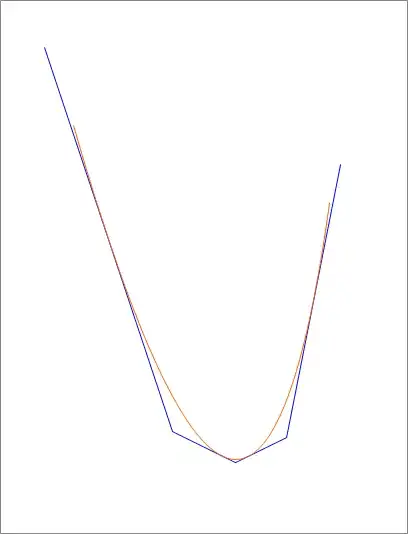Given $4$ lines in the Cartesian plane, defined by
$$ a_i x + b_i y + c_i = 0 , \hspace{5pt} i = 1, 2, 3, 4 $$
I want to find the parabola that is tangent to all four lines.
Here is what I did:
Any conic has the general equation
$$ A x^2 + B xy + C y^2 + D x + E y + F = 0 $$
If we define $ r = [x, y, 1]^T $ , then this equation can be put in the form
$$ r^T G r = 0 $$
where
$$ G = \begin{bmatrix} A && \dfrac{B}{2} && \dfrac{D}{2} \\ \dfrac{B}{2} && C && \dfrac{E}{2} \\ \dfrac{D}{2} && \dfrac{E}{2} && F \end{bmatrix} $$
Since this is a parabola then
$$ A C - \left( \dfrac{B}{2} \right)^2 = 0 $$
Now for $i = 1, 2, 3, 4 $ define $N_i = [ a_i, b_i , c_i ]^T $, then it follows that
$$ N_i^T G^{-1} N_i = 0 $$
This equation is linear in the elements of $G^{-1}$. The resulting linear system in the $6$ unknowns and $4$ equations, can be solved to obtain
$$ G^{-1} = \lambda (P_0 + \sigma P_1 ) $$
where $P_0 , P_1 $ are known by solving the system while $\lambda$ and $\sigma$ are arbitrary. We take $ \lambda = 1 $, and note that
$$ G^{-1}_{33} = \dfrac{ \det(G22) }{ \det(G) } $$
where $ G22 $ is the submatrix of $G$ obtained by by deleting the third column and third row.
Now since this is a parabola, as mentioned above, then $ \det(G22) = 0 $, therefore, we want $G^{-1}_{33} = 0 $. Since $G^{-1} = P_0 + \sigma P_1 $, then $\sigma$ is given by
$$ \sigma = - \dfrac{ P_{033} }{ P_{133} } $$
Having obtained $\sigma$, we can calculate $G^{-1}$ and then invert it to obtain $G$.
From $G$, we now have all the coefficients of its general equation up to a scale. Now it is possible after some manipulation of these coefficients to obtain the vertex and the orientation of the parabola, and, of course, its squared term multiplier. This completes the specification of the desired parabola.
I would greatly appreciate your feedback on this method that I developed, and also other solutions that you might have to the problem.

